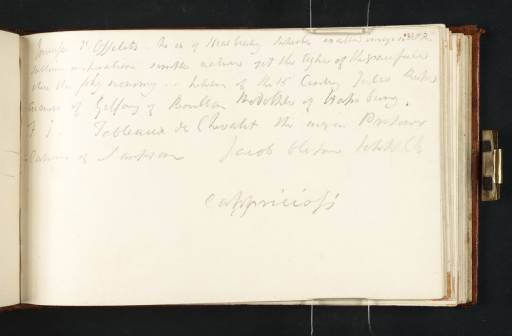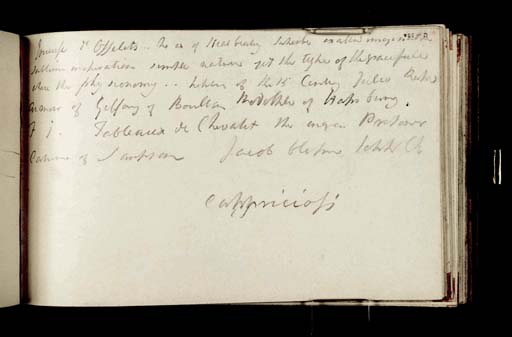Joseph Mallord William Turner Notes on Pictures &c (Inscriptions by Turner) 1807
Image 1 of 2
Joseph Mallord William Turner,
Notes on Pictures &c (Inscriptions by Turner)
1807
Joseph Mallord William Turner 1775–1851
Folio 63 Verso:
Notes on Pictures &c (Inscriptions by Turner) 1807
D06593
Turner Bequest C 58a
Turner Bequest C 58a
Inscribed by Turner in pencil (see main catalogue entry), inverted, on off-white wove paper, 118 x 187 mm
Stamped in black ‘C 58a’ top right, inverted
Stamped in black ‘C 58a’ top right, inverted
Accepted by the nation as part of the Turner Bequest 1856
References
1909
A.J. Finberg, A Complete Inventory of the Drawings of the Turner Bequest, London 1909, vol.I, p.262, C 58a.
Turner’s inscription is somewhat rubbed and the following transcription may be the best that can be attempted now:
Joueuse d’Osselets. No ex of ideal beauty superbe exalted imagination | sublime inspiration simple nature yet the type of the gracefull | where the physionomy [...] picture of the 15 Century Julio Romano | armour of Geffroy of Boullon Rodolphe of Habsburg. | F l. Tableaux de Chevalet the [...] Professor | capture of Sampson Jacob blessing John | Cappricciosi
Finberg got no further than half-way in his own reading of these notes and so missed the references to Giulio Romano and ‘Tableaux de Chevalet’ (easel pictures), which confirm that they refer to works of art even though their identities and locations are unclear. The use of French need not imply that they were seen in Paris (which would be out of the question if the notes are contemporary with the other material in the sketchbook, of 1807 or thereabouts), as Turner could have been making shorthand notes from other publications, prints or illustrations, or on works on the London art market, which had been receiving many works from French collections since the Revolution.
The subject of ‘Joueuse d’Osselets’ (knucklebone players) was a famous one in ancient sculpture, probably deriving from an early Hellenistic prototype; the best known Roman example (Pergamon Museum, Berlin) was in fact brought to Paris in 1807 having been seized by the French army during its Prussian campaigns, and from 1811 to 1815 was displayed in the Louvre with a related Nymph (still in the Louvre) acquired from Napoleon’s brother-in-law, Camillo Borghese. Perhaps Turner had read press reports of its capture. But the subject also appeared in paintings by Dutch seventeenth-century artists. Turner appears to praise the simplicity, naturalism and expression of whatever example he has seen or read about, in contrast to ‘ideal beauty’; this may correspond to his current interest in rustic narrative, evident in the sketches of cottage, farmyard and similar scenes in this sketchbook and his competition with the painter David Wilkie.
It is unclear from Turner’s wording whether he intends any connection between Giulio Romano (circa 1499–1546) and Geoffrey of Bouillon (circa 1058–1100), a leader of the First Crusade to Constantinople, and Rudolf of Habsburg (1218–1291), first German king of the Habsburg dynasty. Perhaps he refers to designs for their armour in some historical scheme by or attributed to the prolific painter and designer. The biblical subjects of Samson and Jacob, mentioned last, are unidentifiable.
David Blayney Brown
May 2006
How to cite
David Blayney Brown, ‘Notes on Pictures &c (Inscriptions by Turner) 1807 by Joseph Mallord William Turner’, catalogue entry, May 2006, in David Blayney Brown (ed.), J.M.W. Turner: Sketchbooks, Drawings and Watercolours, Tate Research Publication, December 2012, https://www


